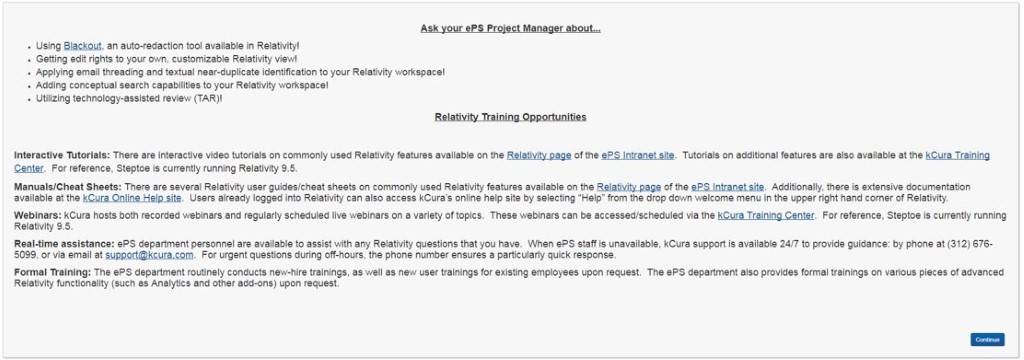Ever feel like you’re fighting an uphill battle to get your firm to adopt analytics technology? You are not alone. Kate Bauer, practice solutions architect at Steptoe has been there—and her success story might be the inspiration you need to pave the way for your firm.
A few years ago, Kate embarked on a journey to up analytics adoption throughout Steptoe. Despite having some skeptics, Steptoe had a handful of things working for them.
For one, the director of the firm’s litigation support department was pro-innovation and routinely worked with Kate to vet technologies that would make the firm more efficient and cost effective.
“He and I were very optimistic about Relativity Analytics,” Kate said. “He was also willing to fund a ‘free trial’ analytics promotion, which was instrumental in helping us make analytics converts at a time when many still perceived the technology as new and scary.”
But, widespread adoption throughout the firm lagged. So Kate and her team strategized on ways to get case teams excited about the tools—eventually averaging 460 gigabytes worth of requests for analytics each month. Here's what they did.
#1: Show them the data.
Telling your case teams that analytics will save them time and money may not get you far. But, telling them how Relativity Assisted Review saved a client $2.7 million, for example, could turn some heads.
This is what Kate did after an attorney within the firm used Assisted Review on a Department of Justice second request. With Assisted Review, the firm reduced review time on the case by 25,400 hours.
Kate said: “Having an attorney advocate for this technology and vouch for the results garnered interest and increased our credibility. Attorneys began to think that analytics might be worth the upfront investment after all.”
#2: Distribute useful resources.
If selling analytics in conversation isn't working, try another avenue. Most people prefer to comprehend information through visual representations.
Kate used this tactic with a brochure that walked readers through using Relativity Analytics on their cases. The brochure included the litigation support team’s responsibilities and contact information.
Remember in elementary school when you used a “cheat sheet” for a quiz? Kate’s brochure was a similar tool for her colleagues’ work with analytics and the Electronic Discovery Reference Model.
"New attorneys usually haven’t heard much about e-discovery until they get into practice,” Kate said. “These documents are a great way to familiarize case teams with the EDRM."
Kate distributes the cheat sheets to new hires and associates during training sessions. Additionally, the cheat sheets provide more context for seasoned attorneys.
"These sheets define terms that attorneys are likely to encounter when discussing production protocols,” said Kate. "The goal is to give attorneys a quick reference guide so that if, for example, someone starts discussing ‘applying email threading to a universe that’s been de-duped within custodians based on SHA1 hash,’ they’ll be able to follow the conversation even if they are not themselves a tech whiz."
#3: Offer training.
Provide hands-on training to show case teams how to use analytics workflows. For Kate’s firm, using the Relativity Message of the Day to publicize available training resources ensured that the firm’s Relativity users knew how and where to obtain assistance.

The firm also required paralegals to receive training in 10 areas of Relativity, including Analytics.
“Paralegals are on the front lines with the attorneys, which means they’re in a great position to identify projects where analytics can benefit clients,” Kate observed. “Tech-savvy paralegals see analytics opportunities that might otherwise be missed.”
While Steptoe offers formal Relativity training for attorneys, Kate said much of what they retain comes from using it on the job. Working side-by-side with paralegals who have received formal Relativity training improves attorney awareness, too.
“With increased awareness comes improved effectiveness and confidence in applying analytics technology—thus enabling greater adoption,” Kate said.
At Steptoe, paralegals looking to increase their technical skills can attend a cross-training program with the litigation support staff. The training instructs paralegals on doing more advanced tasks in Relativity, such as creating a conceptual index and performing structured analytics operations.
“I used to configure and manage every analytics project myself, so I’m a big fan of this program,” Kate laughed. “Having more people who can perform these tasks keeps me from becoming a bottleneck when several analytics requests come in at once.”
#4: Build buy-in for conceptual analytics.
Some case teams may be new to analytics and therefore skeptical of conceptual analytics—the tools that learn about the concepts discussed in your data set.
For these users, Kate suggested using structured analytics tools, such as email threading and textual near-duplicate identification. Structured analytics compare documents word by word to identify emails that belong to the same thread or documents that belong to the same textual near-duplicate group.
“People generally accept that a computer can identify documents with matching text because it’s a fairly straightforward, mechanical process—the kind of analysis we routinely rely on computers to perform quickly and accurately,” she noted. “Analyzing ‘concepts’ is harder to visualize.”
To spur interest, they added conceptual analytics to workspaces that had already requested structured analytics. Then, using the case team’s own data, Kate’s team sent emails showcasing the functionalities, along with offers to do hands-on analytics demos.
Exposing broad trends in the documents, the emails showed examples of clusters. Clustering combines conceptually related documents into groups. Case teams can drill into sub-clusters to explore more granular concepts and flag important concepts by a cluster’s size: the larger the cluster, the more conceptually related documents are in that group.

.PNG)
“The emails were tremendously successful,” Kate said. “Some demos that we scheduled for 45 minutes extended to almost 90 minutes because they were amazed by the depth of analysis they could do using these tools.”
But there’s more to conceptual analytics than just clustering and keyword expansion. Kate noted, in an early demo, she told a deeply skeptical attorney to provide an example of a “hot” document.
“Within a minute, we used conceptual searching to find three more hot documents in a multimillion record database,” Kate added. “The attorney was thrilled.”
Have you had success getting your case teams on board with analytics? We’ve love to hear about it in the comments.











